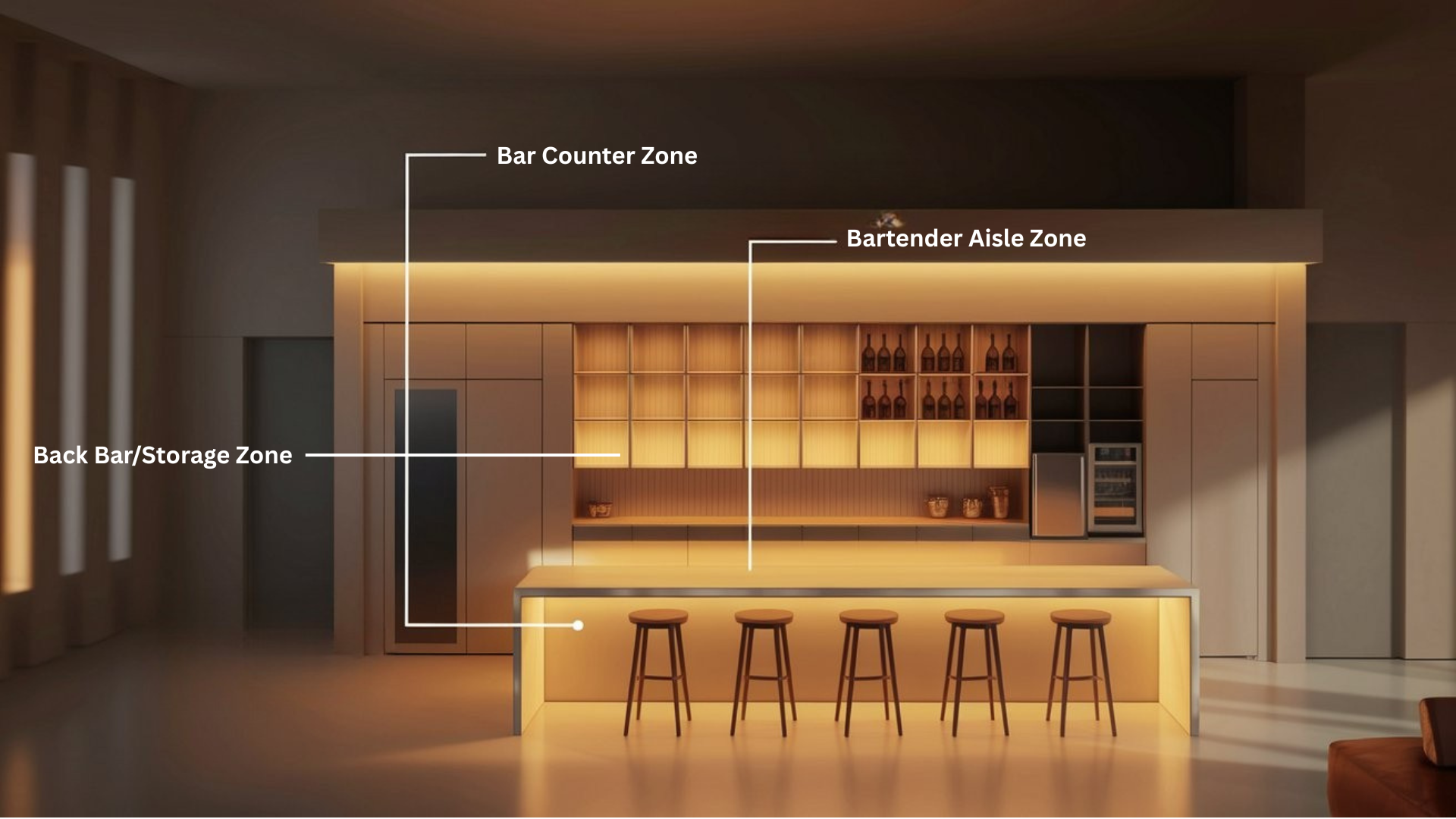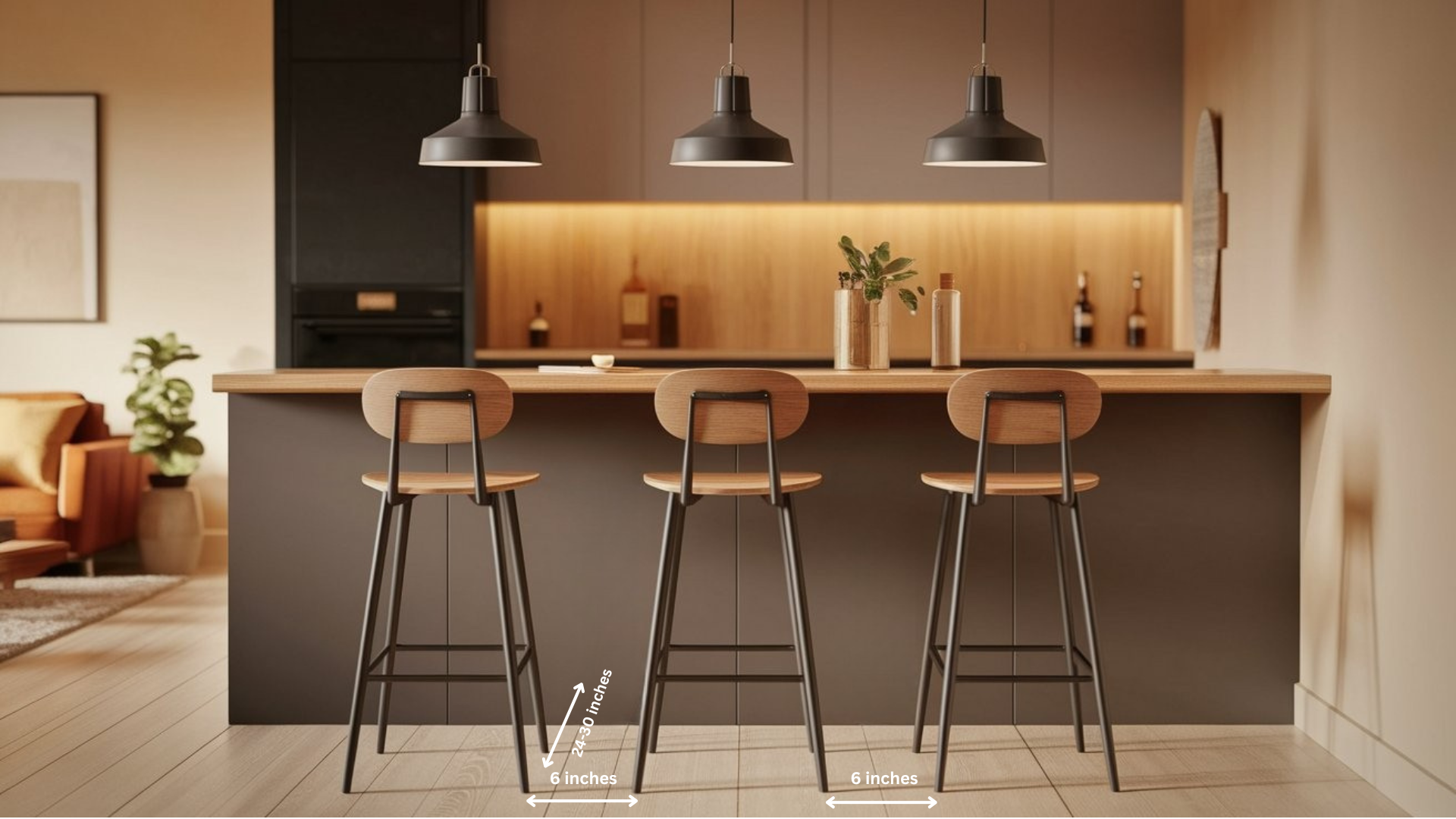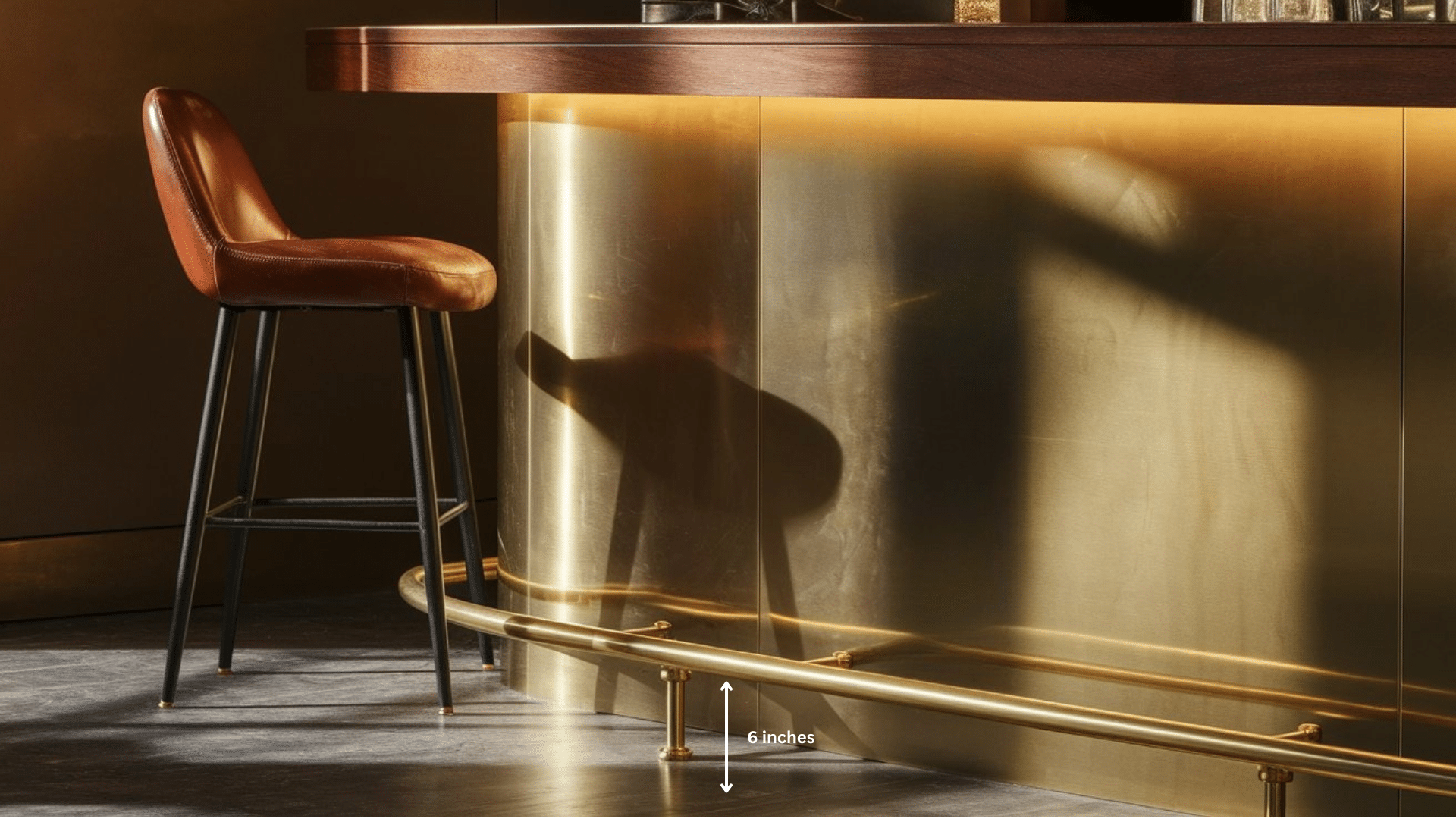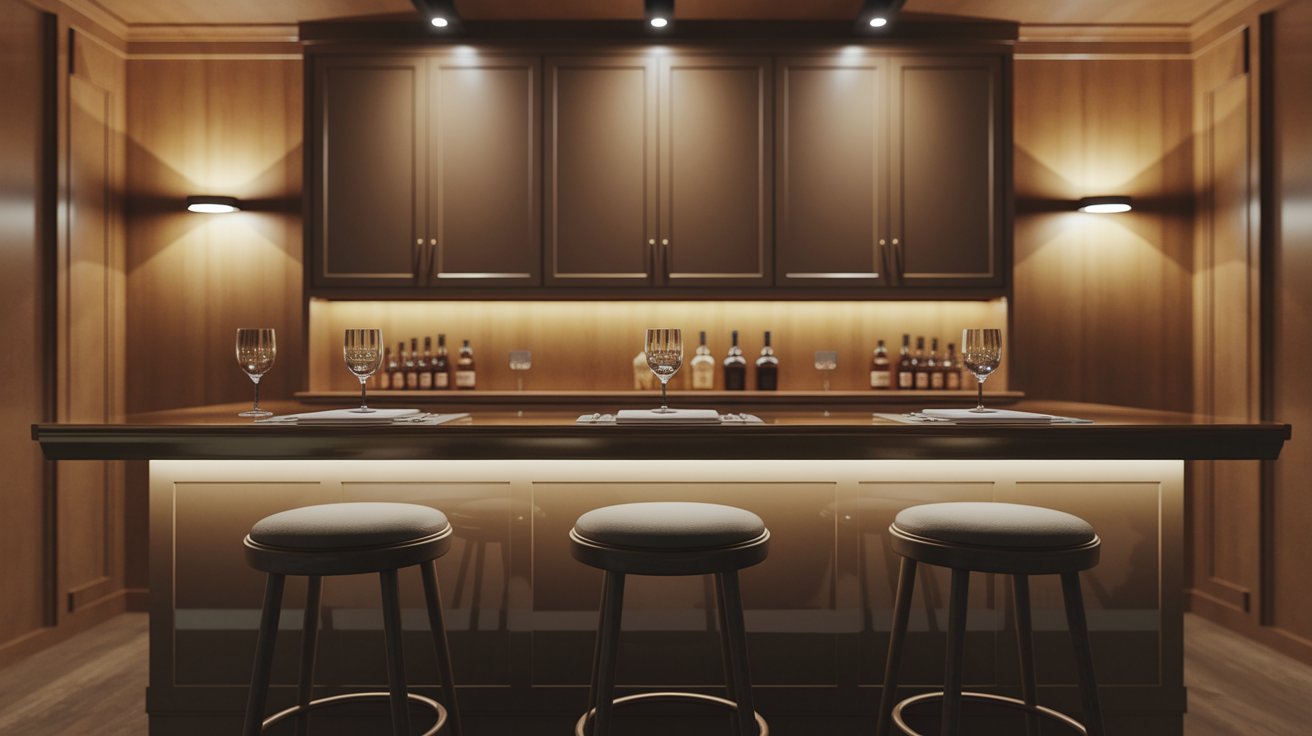Do you struggle with proper spacing when planning your home bar?
I know this feeling too well. Many homeowners install bars only to find they can’t comfortably sit, move around, or store items as needed.
But building a useful home bar isn’t just about looks. It’s about careful planning of heights, depths, and spacing that makes or breaks the experience.
This blog will walk you through the exact measurements for a home bar that works. I’ll share key numbers for counter height, seating space, and work areas, helping you create a space that’s both functional and comfortable.
Let’s start building a bar that fits your space and meets your needs perfectly.
Understanding the Purpose of Your Home Bar
Before grabbing your measuring tape, think about how you’ll use your bar. Your plans should match your needs.
Will you mainly serve drinks to friends during gatherings? You’ll need extra counter space and seating room.
Are you interested in mixing your own drinks? Focus on a wider workspace behind the bar with enough room for tools and bottles.
- Consider who will use the bar most often
- Think about the types of drinks you’ll typically serve
- Plan for storage based on your liquor and glassware collection
Material and Wood Thickness Planning
The materials you choose affect both the look and durability of your home bar. Hardwoods like maple or oak offer great durability, stone provides easy cleaning, and concrete creates a modern industrial look.
Bar tops should be 1.5 to 2 inches thick for a solid feel and proper proportion. Thinner tops often look cheap or flimsy, while overly thick tops can seem bulky and take up valuable space.
The edge treatment makes a big difference in both comfort and style. Bullnose (rounded) edges offer the most comfort, beveled edges add a touch of style, and square edges create clean, modern lines.
Now that you have the materials and thickness in mind, let’s swoop into the specific areas you need to plan for in your bar setup.
Essential Zones in a Home Bar

A well-designed home bar consists of three main zones that work together to create a useful setup.
The first zone is the bar counter, where guests sit and drinks are served. This is the public face of your bar and needs proper height and depth.
The second area is the bartender aisle, your workspace for making drinks and moving around. This space must be wide enough for comfort.
The final zone is the back bar or storage area where appliances, bottles, and glasses are kept within reach.
Bar Counter Zone: This area serves as both a place to prepare drinks and for guests to sit. It needs to be built with the right height and depth for comfortable use. Make sure to plan enough counter space for each person to sit without feeling squeezed.
Bartender Aisle Zone: This is your main working area behind the bar. The space must let you move freely while making drinks. Plan for enough width so you can bend, turn, and reach for items without bumping into things.
Back Bar/Storage Zone: This section holds all your needed items and equipment. It’s where you’ll keep appliances such as mini-fridges, store your bottles and glasses, and organize your tools. This area may feature shelves, cabinets, or both for smart storage.
Recommended Bar Counter Height
The height of your bar counter affects everything from comfort to the type of stools you’ll need. Getting this measurement right is key to a useful bar.
Standard bar height is 42 inches from the floor. This height works well for most adults, standing or sitting on proper bar stools.
For a more casual feel, a 36-inch counter-height bar might be better, especially in family homes or smaller spaces.
- 42-inch standard bar height: It feels like a true commercial bar experience. This height requires taller bar stools specifically designed for bar-height counters. The higher stance creates a clear division between spaces in your home.
- 36-inch counter height: This more family-friendly option uses standard counter-height stools that might match your kitchen seating. The lower height better fits with kitchen counters if your bar connects to the kitchen area.
Consider factors like the height of main users, your room’s ceiling height, and the type of atmosphere you want to create when choosing between these options.
How Deep Should the Bar Top Be?
The depth of your bar top impacts both function and comfort. Too narrow and drinks might fall; too wide and conversations become hard.
The ideal depth range for most home bars is 18 to 24 inches. This gives enough room for drinks and small plates without making the space feel too divided.
The overhang matters just as much as total depth. A good overhang allows for leg room and makes the bar look well-built.
Tips for Bar Top Depth
- 18 inches works for drinks-only bars
- 20-24 inches better if food is served
- Plan for a 10-12 inch overhang on the seating side
Edge Considerations
The edge style of your bar top affects both comfort and looks. Rounded edges provide a more arm-friendly surface for guests leaning against the counter.
Thicker edges give your bar a more high-end, substantial feel that suggests quality construction.
For those seeking a truly special look, waterfall edges that extend all the way to the floor create a striking, continuous appearance that adds a touch of luxury to your home bar setup.
Space Behind the Bar: The Movement Zone
The area where you’ll stand to mix and serve drinks needs careful planning. This space affects how easily you can work.
The ideal width for a bartender aisle is between 31 and 37 inches. This gives you enough room to turn around, bend down to reach items, and work without feeling cramped.
In smaller homes, you can work with slightly less space, but try not to go below 30 inches if possible.
Essential Guidelines for Comfortable Bar Stool Spacing

Proper seating spacing makes the difference between a crowded, uncomfortable bar and one where guests can relax. The rule of thumb is to allow 24-30 inches of counter width per seat.
This gives each person enough elbow room. Leave about 6 inches between stools to prevent them from bumping each other when people turn or move.
When planning your seating measurements, remember that 24 inches is the minimum width per person, while 30 inches provides ideal comfort. The 6-inch spacing between stools creates a balanced layout that feels neither too sparse nor too cramped.
Comfort factors also play a key role in seating design. Allow 8-12 inches of knee space under the counter for guests to sit comfortably without hitting their knees.
Plan for 9-12 inches of clearance from the seat to the bar top to allow proper arm positioning. Bar stools with backs are significantly more comfortable for longer sitting sessions, making them ideal for home bars where guests might linger.
What’s Behind the Bar?
The back bar area holds your working supplies and can make or break your bar’s usefulness.
Back bar depth should be around 24 to 29 inches. This fits standard appliances while leaving working space in front.
Think about going up rather than out. Vertical storage with shelves helps use space wisely without making the bar too big.
Storage Options: A well-planned bar needs smart storage for all your items. Open shelving works for bottles and glasses you use often, while cabinets protect less-used things. For drinks that need cooling, build in a wine rack or mini-fridge that fits your design style.
Visibility Factors: How you arrange items matters for both use and looks. Keep good liquors at eye level and daily items within easy reach. A mirrored back wall makes small bars feel bigger and adds brightness to your space.
Choosing the Right Equipment Size
The appliances and fixtures you select need to work with your space, not fight against it.
Common depths for bar equipment are 19 inches for compact items and 24 inches for full-sized ones. The working surface height should always b roper comfort.
A smaller home bar might do well with the 19-inch depth for appliances, while serious home bartenders might prefer the standard 24-inch depth.
Equipment Planning Tips:
- Check exact measurements before buying.
- Allow 1-2 inches of space around each appliance
- Plan for ventilation needs
- Consider the swing space for doors and drawers
The Ideal Foot Rail Setup
A foot rail isn’t just for looks—it makes standing at the bar much more comfortable by taking pressure off the lower back.

Ideal height: The foot rail should sit about 6 inches above the floor. This height works well for most adults.
Proper placement: For good knee clearance, place the rail 7-9 inches away from the front of the bar. This prevents people from kicking the bar when seated.
Materials: Popular options include brass for a classic look, stainless steel for modern style, and wood to match the bar itself.
Installation: Use proper brackets every 4 feet for stability. Make sure all connections are sturdy to prevent wobbling. Always round any sharp edges or corners to prevent injuries.
Comfort factor: A well-placed foot rail can make the difference between guests staying for one drink or settling in for the evening.
Conclusion
Planning a home bar with the right dimensions makes all the difference in how you’ll use and enjoy the space.
The counter height, depth, and spacing we’ve covered will help you create a comfortable spot that works for both hosts and guests.
Remember that your home bar should fit your specific needs. Use these guidelines as a starting point, but feel free to adjust based on your space and how you plan to use your bar.
The next time you share drinks with friends in your properly sized home bar, you’ll notice how the right dimensions make everything flow better. From mixing to serving to sitting, good planning pays off in both function and fun.
Frequently Asked Questions
How Much Will a Custom Home Bar Typically Cost?
Home bars range from $500 for DIY projects to $15,000+ for custom builds. Budget around $2,000-5,000 for a mid-range quality home bar.
Do I Need a Sink in My Home Bar?
Not essential, but highly convenient for washing glasses and tools. A small bar sink saves trips to the kitchen and helps with cleanup.
What’s the Minimum Space Needed for A Functional Home Bar?
You can create a functional bar in as little as 30 square feet (6×5 feet), though 40-50 square feet allows for better workflow.


